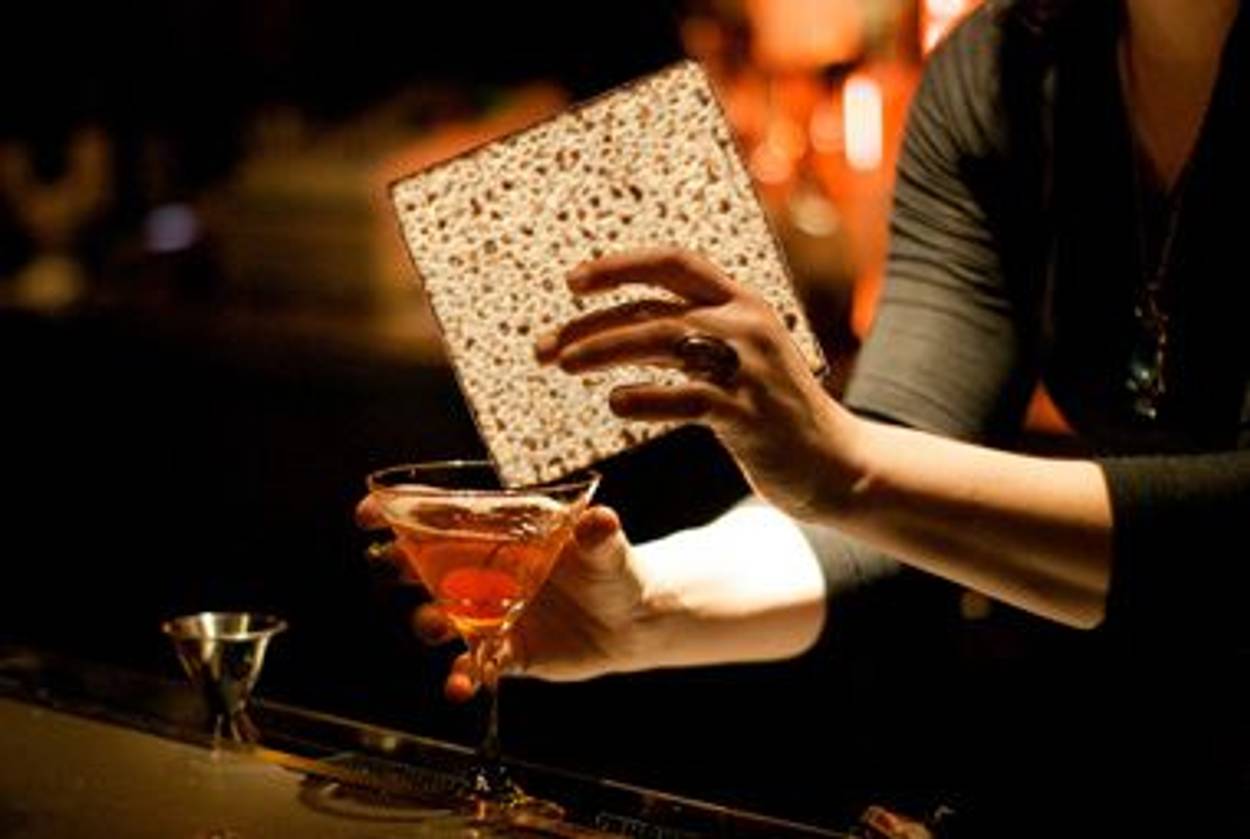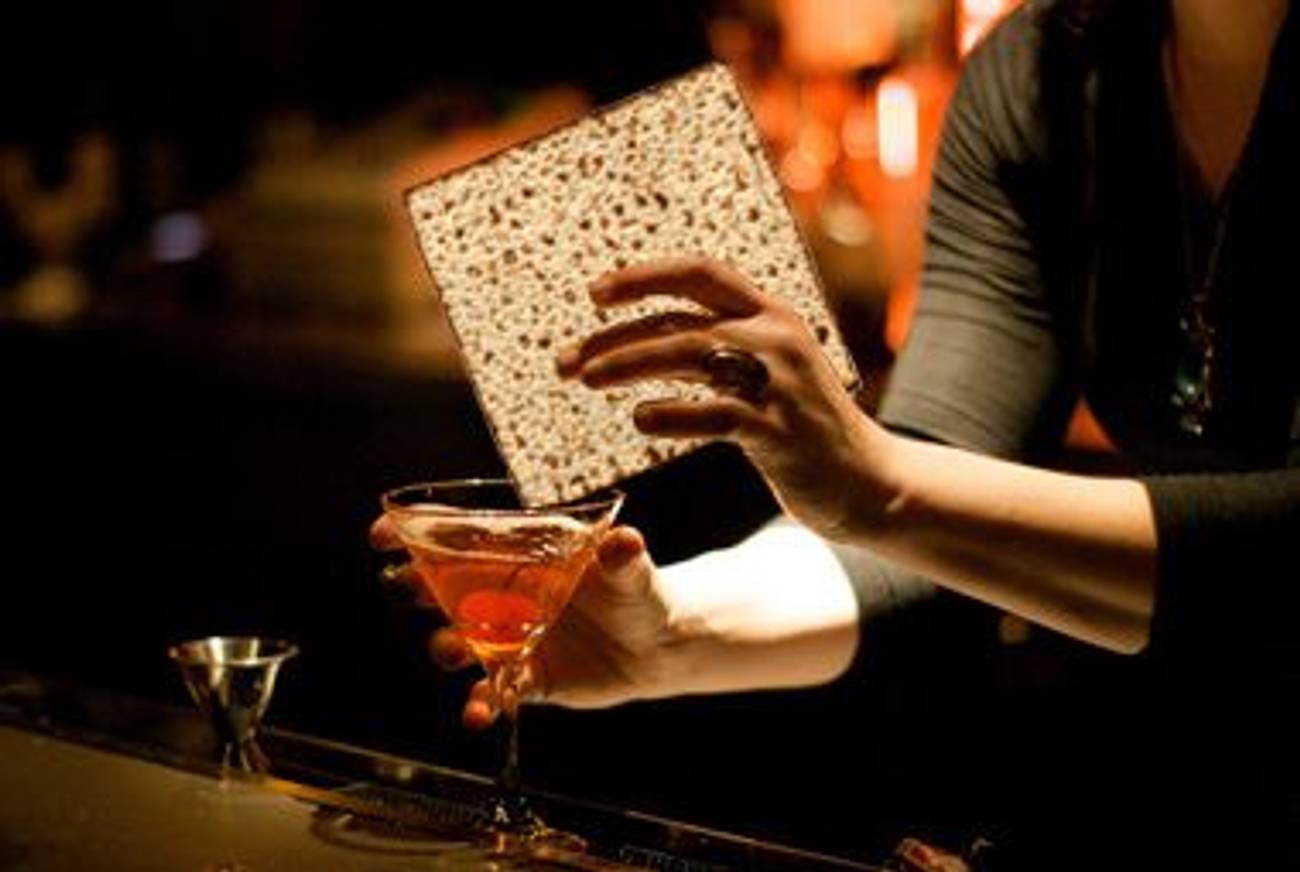Refill
Specialty cocktails inspired by the Seder plate offer the flavors of Passover with a twist




If you’re a Jew on Facebook, you may have seen a link recently to The Sipping Seder, a look at the traditional Seder plate through a modern-day cocktail-lover’s lens. Two connoisseurs of mixed drinks, Rob Corwin and Danny Jacobs, came up with six drinks representing the six items on the plate: Charoset (a sweet paste of fruits and nuts), Maror and Chazeret (bitter herbs), Karpas (vegetable), Z’roa (shank bone), and Beitzah (egg). Sounds like a joke, but when you look at the site, you see that Corwin, 41, and Jacobs, 36, are utterly serious. They thought hard about what gives karpas, say, its essential karpas-ness: Because Sephardic Jews dip their vegetables into vinegar instead of salt water, the cocktail incorporates Balsamic vinegar, parsley, and gin (and a footnote points out that No. 209 Distillery’s gin is kosher for Passover). The beverage is herbal and spring-like, but with an acidic hit—the ritual act in a martini glass.
Corwin and Jacobs are hardly alone in seeking new resonance for ancient ritual. Synagogues and college Hillel chapters host Chocolate Seders; online communities like Challah Crumbs and Kveller share Passover craft ideas; activists for domestic workers’ rights attend Labor Seders. Indeed, my kiddie Seder plate idea last year was a tongue-in-cheek way to rope in the previously alienated, clueless, fidgety, or unable to ask.
Corwin and Jacobs are not big shul-goers. That’s true of most American Jews. “Passover to us means matzoh brei and matzoh pizza and matzoh lasagna,” Corwin said. “It means going to a Passover-inspired dinner at one of the few restaurants in San Francisco, where we live, that does that sort of thing. Most of the Seders we’ve been to have been attended mostly by gentiles.”
They came up with the idea for the cocktail Seder on a trip to Beijing, where they discovered a Manuka-honey-flavored vodka from New Zealand. At home, they experimented with adding sweet vermouth, and Jacobs had an instantaneous sense memory of charoset.
The two men come from different Jewish backgrounds—Jacobs grew up in an observant Jewish family; Corwin’s parents are intermarried. Most of their friends are “vaguely non-practicing,” Corwin says. “But everyone pricks up their ears when we talk about cocktails.”
Their site seems to have struck a chord. “We’ve been surprised to find that people who visit tend to spend six to 30 minutes there,” Corwin says. “People look at more pages than we have, which means they’re revisiting pages. I hope it means we’ve attracted some people to learn about Passover who wouldn’t otherwise know anything. We just wanted to make people smile. That would be enough. But if helps people connect to their heritage, that would be wonderful.” Dayenu.
Soon after the site launched, a woman in Alaska—married to a non-Jew, living in a community with few Jews and no shul, who still wants her children to have a Jewish identity—posted a comment on the site. She wrote that she held Passover cocktail and food pairings every year, featuring offers like a Hillel sandwich with a Junípero martini, and a Bloody Mary with savory smoked-salmon matzoh brei. She signed her comment “Frozen Chosen.”
Corwin and Jacobs also used ingredients they felt had resonance, inspired by a Seder they attended at the restaurant Perbacco a few years ago. The menu was co-created by Joyce Goldstein, author of Cucina Ebraica: Flavors of the Italian Jewish Kitchen, and many of the dishes included artichokes, a staple among Italian Jews. Corwin and Jacobs and their friends talked about how the prickly veggie could represent the Jewish experience throughout history. They wound up using the artichoke liqueur Cynar in their Chazeret cocktail. The Beitzah cocktail incorporates egg whites and Galliano (but not in a “foofy Harvey Wallbanger” way, Corwin promises). “Our first attempts lacked finesse,” Corwin says, “but now it has a more sophisticated flavor profile, and I think it looks like a roasted brown egg, especially in the tulip-shaped stemware we used.”
The most shocking-looking drink is the z’roa, which, in this innovative iteration, represents not just the lamb’s shank bone but its blood.
2 oz. Basil Hayden’s Bourbon
2 oz. ruby port
1 teaspoon gum syrup
¼ oz. lemon juice
¼ teaspoon Maraschino liqueur
Combine all ingredients in a mixing glass. Shake well with ice. Strain through a fine mesh strainer into a chilled cocktail glass.
“I recently had blood drawn,” exclaimed Corwin, “and I couldn’t believe how much we got right. The bubbles are thick around the edges of the glass from the gum syrup, and the viscosity is just right. It kind of creeped me out. The phlebotomist thought I was insane.”
Worried that the site might be seen as mocking the Passover ritual, Jacobs asked his cousin Irwin Keller to take a look. Keller, known as Reb Irwin, is the spiritual leader of a Reconstructionist congregation in Sonoma County. He also has a law degree from the University of Chicago, wrote Chicago’s gay rights ordinance, is the former director of the AIDS Legal Referral Panel in San Francisco, and plays Winnie in the Kinsey Sicks, “America’s favorite dragapella beauty shop quartet.” According to Tablet contributor Esther Schor, when the group is on the road, Keller gives bar mitzvah lessons via Skype in his dressing room. He talked to me on the phone about the Sipping Seder as he made borscht.
“I think it’s important for us to be open to new ways for our ritual tradition to speak to people,” Keller said. “A lot of people have had ritual experiences they’ve felt to be empty. The commandment is to tell the story as if you yourself had left Egypt; the commandment isn’t to do it with gefilte fish, without the jelly please. I think it’s better to have the content in fewer forms than all the forms with less meaning.”
Indeed, Keller says, sitting around having cocktails with friends is a recipe for connection and introspection. He suggests participants consider incorporating a ritual like the Four-Question Seder, developed by Amichai Lau Lavie, the founding director of Storahtelling:
• What was the oppression that you fled?
• In what ways are you still stuck in a narrow place, and what do you need to be free?
• What are you grateful for right now?
• What can you do (once you sober up) to stir up some more freedom in the world?
“The idea of posing starter questions out of our Pesach story makes sense,” Keller said. “No one is required to read Aramaic or know the songs or have complex, ambivalent feelings about their Jewish education or lack thereof—it’s democratic.” Furthermore, he added, “There’s great elegance to the idea, and I think people are attracted to beauty. It’s hiddur mitzvah [the principle of enhancing a mitzvah through esthetics].”
Zachary Sharaga, owner of the Alphabet City speakeasy Louis 649, understands. “I went to an Orthodox yeshiva in Pelham Parkway—tzitzit and all—until second grade,” he told me. “Then I attended a Modern Orthodox school until the end of eighth grade. I’m a first-generation American, and I was raised following the Orthodox traditions, but my immediate family was pretty secular. I’ve battled with several degrees of piety and observance throughout my life, becoming fairly observant in my mid-late teens. Currently, I’m secular but very proud of Judaism.” He’s hosted several Seders, always with “crappy Kosher for Passover wine.” But he was inspired by the Sipping Seder to create a recipe for the second Seder this year, which he’ll be hosting. “I’m going to do a pitcher of Negronis,” he said. “But I’ll adapt it to be more bitter, and I’ll make a pitcher because it’s hard enough to get the food on the table for all those people. If you’re hosting, you don’t have time to be shaking individual cocktails. But you could do individual servings for a party.”
MAH NISHTANAH
1 oz. Plymouth Gin
1 oz. Campari
1 oz. Cynar
Pour ingredients over ice into a large Old Fashioned glass or wine goblet. Garnish with sprigs of dill and parsley and an orange twist.
“The fact that the garnish is a long twist of orange is a perfect reference to the orange on the Seder plate,” Sharaga reflects. “And it’s red, which feels very Passover.” He thought a potato-vodka-based drink incorporating myriad flavors of the holiday would be great too.
PASCHAL PUNCH
1.5 oz. potato vodka
1 oz. Lairds apple brandy 100
1/2 oz. pomegranate juice
1/2 oz. lemon juice
3/4 oz. honey (or to taste—I prefer less sweet)
1 tablespoon red khreyn (horseradish with beets) or 1 tablespoon fresh grated ginger
Shake and strain through a fine mesh strainer, over ice, into a large Old Fashioned glass or wine goblet. Garnish with wedges of apple and/or pickled beet (I love Rick’s Picks Phat Beets).
As if all this were not enough, Charles Steadman, bartender at Echo Palm Beach, provided a final recipe.
DAYENU
1 1/2 oz. Karlsson’s Gold (a potato vodka)
1/4 oz. Averna liqueur
1/2 oz. fresh lemon juice
3 oz. sparkling apple cider (chilled)
1 dash Regan’s Orange Bitters No. 6
Garnish: Watermelon radish sliced in half
Combine Karlsson’s, Averna, lemon juice, and bitters in mixing glass with ice. Stir for 30 seconds to dilute. Strain into a martini glass and top with chilled sparkling cider. Garnish with radish.
Is all this a decadent fin de siècle indication that our religion has lost its moorings or a hopeful hint that our heritage lives on despite intermarriage, the failings of Jewish education, and the American drive toward acculturation? You tell me.
Special thanks to Francine Cohen, Editor-in-Chief, INSIDE F&B.
Marjorie Ingall is a former columnist for Tablet, the author of Mamaleh Knows Best, and a frequent contributor to the New York Times Book Review.